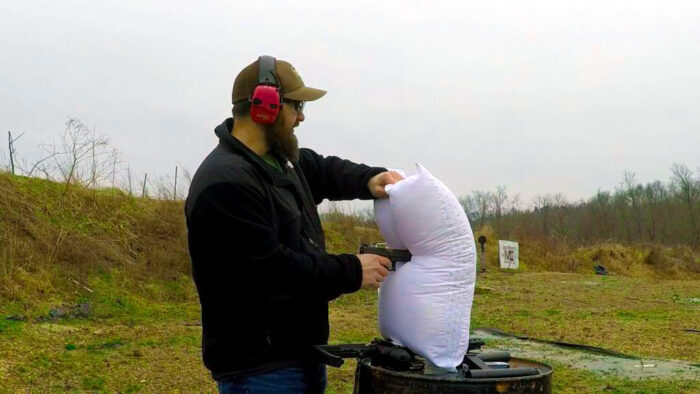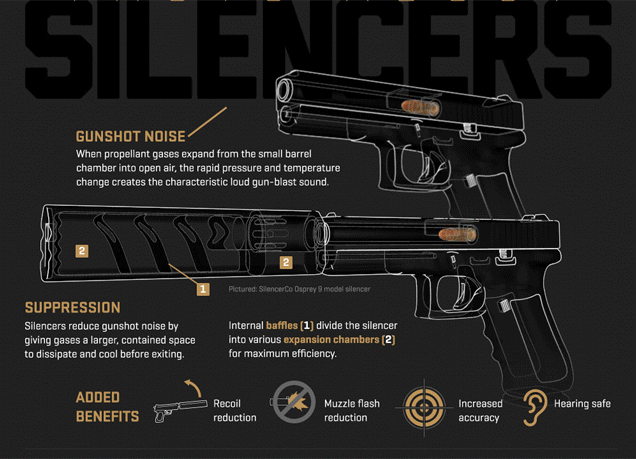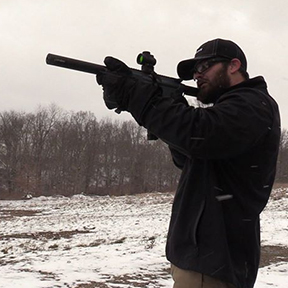A Pillow Silencer: Firearm Movie Myth
We have seen it in at least one movie: a pillow gets placed in front of a firearm and suddenly the gun sounds like a BB gun. I think most people would believe the common movie trope to be exaggerated to some degree. However, the question remains: How much of that is fiction, and how much is grounded in reality? Well, we went out and tested it and have a decent audio representation of the difference between a pillow and a real silencer.
So the next logical question would be, “why doesn’t a pillow work very well”? The answer all comes down to expanding the gas. In order to decrease the muzzle report of a firearm, we must redirect it, slow it down, and cool it down. On the surface, a pillow looks like a good candidate, with a lot of loosely packed material to stop the gas. Great for supporting your head/neck at night and ripping more hair out of your balding spot, but it falls short of being actually quiet.
Enter the Silencer
First off, the major difference is a silencer is ridged in nature and built to contain expanding gas, redirecting the gas down a set path. In case you aren’t tracking, a pillow is not designed to perform these functions. From a general view through the pillow does have some similar structures like a casing and a porous structure internally. So let’s look at the process a silencer uses to take the edge off the violence that comes out of the end of the gun. The easiest way to conceptualize this is in terms of a single particle and it’s journey through the silencer. (this is a major simplification, fair warning)
Our particle starts off hot, fast, and moving in a particular direction (a random vector away from the muzzle). It then runs into the inside of the can making it bounce. When it does this it transfers some of that kinetic energy to the can in the form of heat. This particle continues in motion, this time striking several other particles before making contact with the wall of the suppressor again. Each of those particles bounced off our particle of focus, changing their direction slightly and losing some of their energy. This process of destructive interference continues trillions of times across the volume of the silencer until all of the particles have been slowed and cooled to an inert status. The byproduct of this is a very hot device after just a few rounds.
In the video, we saw quite a different story when discussing the pillow. While the stuffing of the pillow is many orders of magnitude more chaotic than what is going on inside the silencer, it simply lacks the rigidity to cause the aforementioned redirect effect. The end result being displacement of the stuffing by the gas, rather than the other way around. Visually, of course, that means the launching of stuffing from the pillow, which I found quite comical. The small amount of resistance by the pillow did create some gas disruption and a measurable muffling effect. The pillow just wasn’t as potent as the silencers featured in the video, which were metering approximately 120-125 dB. Which, compared to things most people experience in their daily lives, are still relatively loud.
Let's Get Real
Of course, I don’t think anyone is going to be going out there using a pillow for any practical purpose. However, I would like to point out that there are some practical takeaways here.
I’ll use the concept of reductio ad absurdum to illustrate a point by dealing in extremes. We can use the example of the pillow to understand why some silencers available for purchase today may not perform. If a can does a poor job of the previously described process than it will inevitably perform poorly.
Well, you might ask, “why would someone do such a thing? Surely, a manufacturer would have this foremost in their mind when designing the device”.
First off, my name is not Surely. Second, there is a recent trend where manufacturers are designing silencers with the key feature of “not being gassy”. The idea being, on semi-automatics, it is better for the silencer to be loud than have gas at the shooters face.
In Terms of Maximum Suppresson:
By design, a properly functioning can will create such back-pressure that the expanding gas will have to go somewhere. It is better that the gas has changed direction 180 degrees to come of the ejection port than out the front. Gas expanding out the front of the suppressor is directly counterproductive to suppression.
Much like our pillow example, any silencer that is being marketed to the consumer as allowing gas to flow through the silencer unimpeded by baffles should be immediately suspect. Remember that you are only given one set of ears. Hearing loss occurs as a result of cumulative exposure, so save your ears.

Currently, there is no precedent set for legal recourse against company marketing products as “hearing safe”, that isn’t hearing safe. Unfortunately, too many companies are designing in the name of novelty instead of hearing protection.
Owner of the VSO Gun channel and President of VSOrdnance, a firearms industry R&D firm. Curtis specializes in breaking new products if there is a weakness he finds it. From firearms to accessories VSO covers it all.



